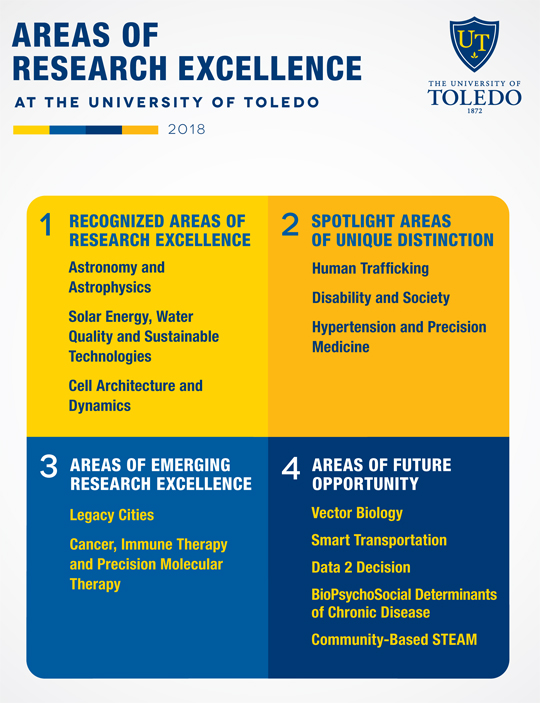The University of Toledo has identified three areas of research excellence as it pursues its goal of achieving national recognition for contributions to advancing knowledge.
UT’s current areas of research excellence identified by the University Research Council and endorsed by external reviews are:
• Astronomy and Astrophysics;
• Solar Energy, Water Quality and Sustainable Technologies; and
• Cell Architecture and Dynamics.
 “These areas emerged from a yearlong review process and were selected because of the highly accomplished faculty members UT has in these areas who are recognized nationally for contributions to their fields of study,” Vice President for Research Frank Calzonetti said. “Identifying these areas of excellence will help promote the University’s standing as a strong research university and create opportunities for collaboration.”
“These areas emerged from a yearlong review process and were selected because of the highly accomplished faculty members UT has in these areas who are recognized nationally for contributions to their fields of study,” Vice President for Research Frank Calzonetti said. “Identifying these areas of excellence will help promote the University’s standing as a strong research university and create opportunities for collaboration.”
This will be a continual process with ongoing invitations to consider new areas and to update existing areas of excellence, Calzonetti said.
UT astronomers have produced groundbreaking discoveries in the origins of stars and star clusters. They have access to highly competitive time on the world’s best telescopes, including NASA’s Spitzer Space Telescope and the European Space Agency’s Herschel Space Observatory. UT also is a partner with Lowell Observatory, which provides guaranteed access to the Discovery Channel Telescope in Arizona. The University regularly engages undergraduate and graduate students in research projects with that telescope.
The strength of the University’s astronomy and astrophysics program was recognized nationally in 2016 when UT was selected to join the prestigious Association of Universities for Research in Astronomy, which includes many of the country’s top programs.
Solar energy, water quality, and sustainable technologies were identified in part due to the University’s strong reputation in research, development, and commercialization of thin-film photovoltaic technologies. For example, in solar energy, Dr. Yanfa Yan, Ohio Research Scholar chair and UT professor of physics, has one of the strongest publication records among researchers in his field.
The UT Lake Erie Center receives attention for its work studying harmful algal blooms in Lake Erie and its efforts to protect the quality of the region’s drinking water. Additional faculty members are making important contributions to green chemistry and other sustainability studies.
The cell architecture and dynamics category recognizes the basic science researchers involved in the study of the cell and its structures to better understand cell movement and how that affects disease progression. For example, Dr. Rafael Garcia-Mata, associate professor of biological sciences, has three active National Institutes of Health grants to study the migration of cancer cells away from the primary tumor and their subsequent metastasis to distant organs.
The identification of these areas of research excellence and a plan to advance them is part of the University’s strategic plan. As part of the process to identify existing strong research programs, the Office of Research and Sponsored Programs also recognized spotlight areas of unique distinction, areas of emerging research excellence, and areas of future opportunity.
The spotlight areas of unique distinction include programs that have received national recognition with strong faculty leadership, but with few faculty experts on campus currently advancing that field of study. Those spotlight areas identified are:
• Human Trafficking, led by Social Work Professor Celia Williamson and supported by the UT Human Trafficking and Social Justice Institute;
• Disability and Society, which includes Professor Kim E. Nielson, who is the author of the only book to cover the entirety of American disability history titled “A Disability History of the United States.” UT also offers the only humanities-based undergraduate degree in disabilities studies; and
• Hypertension and Precision Medicine, led by Distinguished University Professor Bina Joe, a recognized leader in the field of genetic determinants of high blood pressure.
Identified areas of emerging research excellence are those with growth opportunities based upon the significance of their work to science and society. The areas that could benefit from further development are:
• Legacy Cities, which includes a collaborative group of faculty members across the social sciences who study how former industrial cities that experienced massive decline are being reinvented, and
• Cancer, Immune Therapy and Precision Molecular Therapy, which features advances in targeting specific genes or proteins for more effective and less invasive treatment options.
Lastly, areas of future opportunity were identified where a group of faculty members are working in an area of emerging importance in science, technology and society. The areas that could gain recognition through focused investment are:
• Vector Biology, which studies mosquitos and other insects that transmit diseases and affect public health;
• Smart Transportation, which includes advances in autonomous vehicles;
• Data 2 Decision, which is the study of big data and how it is used, analyzed and protected;
• BioPsychoSocial Determinants of Chronic Disease, which studies the economic and social conditions that impact health factors, such as the work underway by UT’s opioid task force; and
• Community-Based STEAM, which features community partnerships, such as with the Toledo Museum of Art, that advance the arts and promote continued education. STEAM is an acronym for science, technology, engineering, art and math.
“The University of Toledo has strong research programs across the institution,” said Jack Schultz, senior executive director for research development. “Our goal with this process was to identify those areas with a high level of recognition at the national level. We look forward to exploring opportunities to elevate their standing and bring more attention to these areas of research excellence.”
The identification of the University’s focus areas does not imply that research without these designations will be unsupported. The University values all faculty research and the contributions each faculty member makes in their fields.